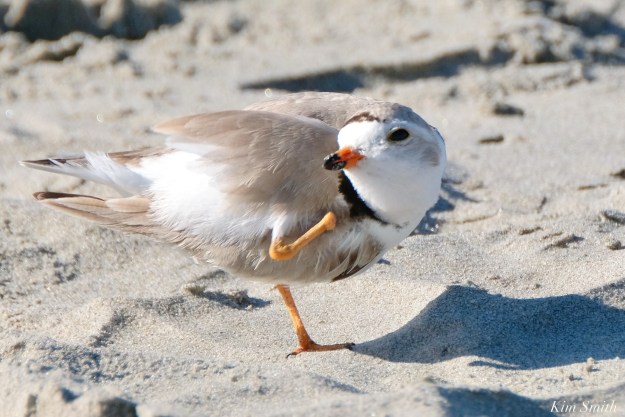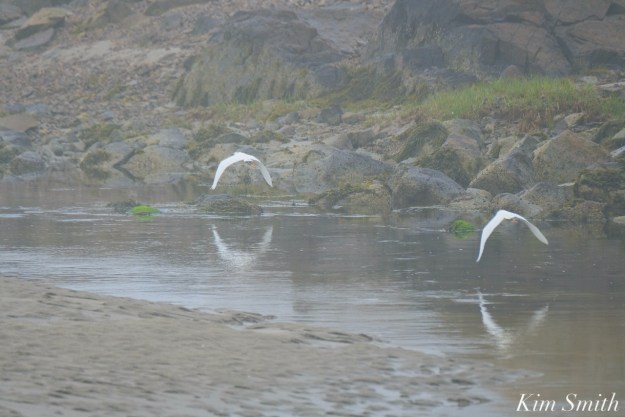A story of patience, fidelity, resilience, and hope
You may recall that last year our Piping Plover Mom’s foot became entangled in what appeared to be both dried seaweed and monofilament. Mom visibly struggled with her foot entanglement. Although initially she could still thermoregulate the chicks and stayed nearby, we began to see less and less of her. Much of the parenting of chicks was left to Dad as she was infrequently seen lying low in the tall beach grass. We wondered if she even made it through the summer.
Mom’s very painful looking injury caused her to behave as though she was trying to adapt to the awkwardness of carrying a ball and chain. Sometimes the chicks would get caught in the seaweed and monofilament entanglement and she was continuously pulling at it, trying to remove.
Fast forward to April of this year. For a month we have had a new pair of Plovers attempting to nest, first at area #3, the original pair of Plover’s original nesting site (beginning in 2016), and then I believe shifting further north up the beach, toward Salt Island. I checked on that pair on Wednesday morning, the fifth, just before leaving for Ohio and despite the unseasonably cool temperatures and rough winds, everything was as it should be in Ploverville.
Upon our return Monday morning all had turned upside down in the world of Plover nesting. It took me a day to understand what had taken place. Miraculously, our original Mom and Dad have returned to #3. We are overjoyed to see them both, Mom especially, but the bittersweet of it is that she has lost her foot.
Dad is clearly eager to mate but, for lack of a better word, is being extraordinarily patient with Mom. She spent the first few days after arriving quietly lying in the grass, so much so we were becoming concerned. But Mom has rallied and is showing interest in Dad and his nest scrapes. He is very attentive, staying nearby and defending her against real and imagined intruders. We all got a laugh when Assistant Library Director Beth Pocock’s commented, “Not very Darwinian of him.”
Dad in one of his nest scrapes
The pair are approximately five weeks later in arriving than the past several years. It’s not entirely unexpected that Mom’s foot has been amputated by the monofilament and seaweed wrapped so tightly that it was cutting off her circulation. Plovers historically have survived with one foot/leg. One of the most common reasons for loss of foot or leg is when debris becomes caught in a leg band on Plovers that have been banded. The thing is, it is taking double the amount of effort for Mom to do things that Plovers ordinarily do daily. Her gait step is twice as many steps as compared to Dad’s. She is spending a good amount of time lying down, rather than standing.
Piping Plovers show tremendous fidelity to each other and to their nesting site. Our Good Harbor Beach Original Plovers are fantastically resilient — recalling just one of their many trials and adventures — the year they nested in the parking lot, driven to this measure by the plethora of dogs allowed off leash by their owners; dogs running and prancing through the Plover’s roped off area disrupting their nesting.
Will Mom be able to breed and take care of chicks this summer? Only time will tell. But because she is now “handicapped,” it’s imperative that we eliminate all disturbances.
 Mom is able to use her peg leg to scratch an itch
Mom is able to use her peg leg to scratch an itch
On Saturday, we had a serious problem with several very large groups of teens drinking, creating a mountain of trash, playing in the nesting area, and running through the area to use the dunes as their bathroom. Their complete disregard of the clearly marked off area destroyed the Plover’s nest scrapes, which are the potential possible sites for eggs. The police were called. The officers were very patient with the teens. One girl in particular was extremely rude to the officers, barely coherent and nearly falling down drunk. It took more patience than you can possibly imagine for the officers to de-escalate as they did. It wasn’t until the police appeared that the teens began attempting to clean up their trash, which without the officer’s insistence that they clean up, surely would have resulted in the more than one huge trash bag that I filled this morning.
These were not local kids but we have to do better than this as a community. There must be a way to have some authority figure patrol the beach on warm spring and summer afternoons. These teens were completely smashed and the amount of trash from alcoholic beverages was astounding. As soon as the officers appeared on the beach, the teens began to clean up their behavior, language, and garbage. But I don’t believe it should have gotten to this point.
We’ll keep an eye on the weather and we Ambassadors will mobilize on the next warm beach day but frankly, we have very little authority. None of us feel safe approaching a group of 30 or 40 unruly and intoxicated (and foul mouthed as was the case Saturday) teens. Truly, the ideal solution is to assign an officer or ranger to patrol the beach on warm afternoons and evenings.
If anyone sees people rough housing in, playing in, or repeatedly entering the roped off areas, please call the police and explain what you are seeing. If a nest with eggs or an adult or a chick is harmed in any way or killed by this kind of behavior, that is considered a “take” by both state and federal regulations. The City and the individuals responsible are liable for thousands of dollars in fines and potential closure of Good Harbor Beach. Our mission is to keep our beautiful GHB open for everyone and to keep our Plovers safe. From Saturday – how people treat our beautiful beach – trash on the beach brings crows and gulls, which eat Plover eggs and chicks
From Saturday – how people treat our beautiful beach – trash on the beach brings crows and gulls, which eat Plover eggs and chicks
Like this:
Like Loading...





















































































































